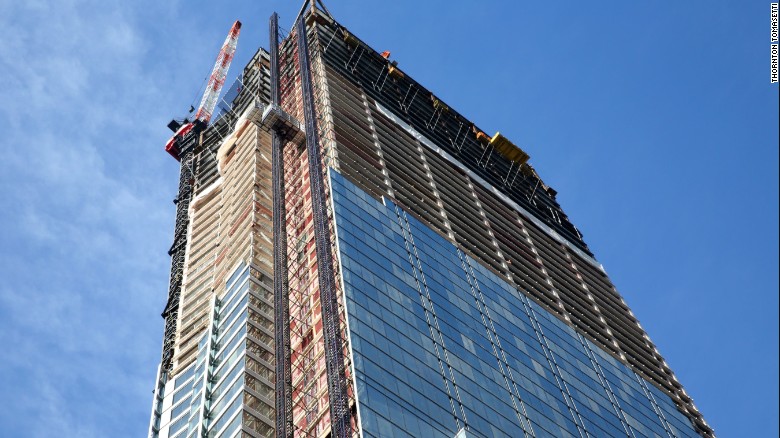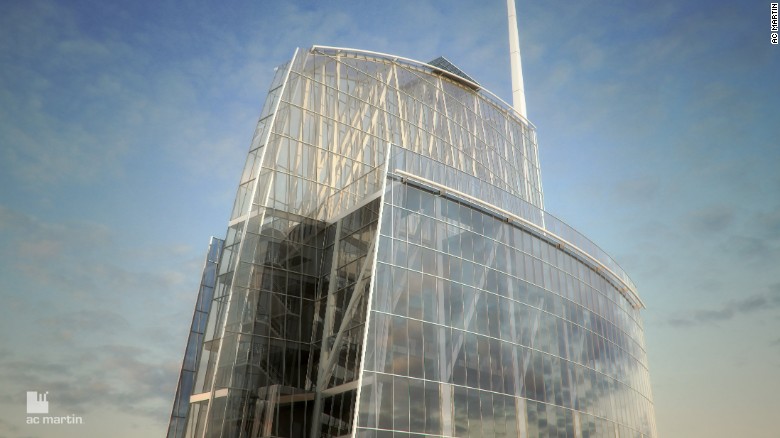(CNN)The New Wilshire Grand Center in Los Angeles has been described as one of the most complicated skyscraper projects ever attempted.
At
1,100 feet, the billon-dollar tower will be the tallest building on the
Pacific Coast when it opens next year, outstripping the nearby US Bank Tower.
The
new arrival will still fall short of East Coast skyscrapers such as New
York's One World Trade Center (1,776 feet), and even the Empire State
Building (1,250 feet), built in 1931.
But
while architects in The Big Apple have little cause to fear that their
creations will be wiped off the map, their Californian counterparts must
design for one of the most earthquake-prone regions in the world.
Tall order
The Wilshire Grand will contain office space, leisure amenities and a 900-room hotel.
Architect
AC Martin designed the building with a cigar box shape to meet the
needs of a hotel, with long corridors for guest rooms on each floor. But
the shape makes it vulnerable to the extreme conditions of the region.
"This
was the most complicated and the highest seismic-demand project I have
been involved in," says engineer Leonard Joseph of Thornton Tomasetti,
who managed structural requirements of the Wilshire Grand, and
previously worked on the Shanghai Tower and Petronas Towers of Kuala
Lumpur.
"A long and narrow
building in an earthquake is quite stiff and strong in the long
direction, but more flexible in the crosswise direction, so that was the
challenge here."
The design team
settled on a plan for a concrete core with a steel perimeter frame,
connected by braces known as outriggers at three levels of the tower.
Joseph compares the latter elements to the arms and poles of a skier,
providing balance on the slopes.
Rock and roll
Before construction could begin, the design had to be tested against a variety of earthquake simulations.
Geotechnical
engineer Martin Hudson modeled the effects of 11 earthquakes on the
building, using historic data to recreate quakes that had struck
California before.
"Several
(simulations) represented earthquakes fairly close to the site, and we
also looked at what happened with an earthquake on a larger fault such
as San Andreas, 100 kilometers from the site," says Hudson.
"The
overall shaking from the two sequences is not vastly different but the
characteristics are. The closer earthquake has higher frequency
vibrations like a truck hitting the building, and the San Andreas
earthquake is more of a long, rolling motion."
Hudson
played with different scenarios, including combinations of earthquakes
and varying degrees of severity, to see if the Wilshire Grand would
survive them.
Final cut
The
simulations revealed alarming weaknesses. Certain earthquake scenarios
would exert enough force on the outriggers -- the arms of the skier --
to cause severe damage to the concrete core.
Plans
also had to be revised for the top of the building, originally intended
to be a "lacy" glass crown and spire, inspired by the Eiffel Tower.
"But
the Eiffel Tower does not have high seismic loads," says Joseph. "A
thinner spire would have been lovely, but it would fail under earthquake
loads."
The top was redesigned to
be more robust, although the glass crown was retained, in contrast to
most of LA's tall buildings that were required to have a helipad on the
roof until 2014.
The geotechnical tests also informed specifications for laying the foundations -- which would set a new world record the largest continuous concrete pour.
Managing movement
When the earth moves, even the grandest structure goes with it, and engineers must plan to adapt.
"You
don't want a building to be overly stiff because the more it fights the
ground movement, the bigger the force developed inside the building,"
says Joseph. "It should roll with the punch."
The
Wilshire Grand features a seismic joint between the base and the tower
that allows for seven feet of sway without causing damage to partitions
or pipework. The building would move more at the top -- potentially at
greater speeds than a shuttle launch -- but as Joseph point out: "it's a
good thing there is nothing next to it there."
The
engineer does not expect the building to emerge from a major earthquake
completely unscathed, and planned for a degree of damage.
"(We)
accept the idea of damage at selected, pre-established locations such
as coupling beams," says Joseph. "There would be a whole bunch of
cracking concrete at the end of these beams in an earthquake, but they
hold together and don't drop on someone's head."
Rising skylines
With the major obstacles cleared, Joseph anticipates smooth progress towards the building opening next year.
The Wilshire Grand will be quickly joined by several more West Coast skyscrapers passing the 1,000 feet mark, including the Salesforce Tower in San Francisco and the 4/C in Seattle.
Structural engineer Grace Kang of the Pacific Earthquake Engineering Research Center (PEER) believes that advancing technologies are making safer, taller construction possible.
"The
computational power available is extremely strong compared to five or
ten years ago," she says. "This has enabled the profession to conduct
more simulations (and) the database for ground motion records has
increased tremendously."
Kang adds that emerging methods are further expanding the possibilities of earthquake engineering.
She cites dampers that absorb and redistribute shock as a promising development for new and retro-fitted tall buildings, while base isolation that "decouples the ground motion from the superstructure" could offer further safety breakthroughs.
The coming years could see a dramatic surge in the skylines of earthquake-zone cities.
http://edition.cnn.com/2016/09/23/architecture/quakeproof-skyscraper-new-wilshire/












No comments :
Post a Comment